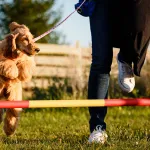Pet care
Effective Training Reinforcement for Your Dog

Whether you’re an experienced dog owner or a first-timer, understanding the importance of training reinforcement is key to achieving lasting results. At Calidognia, we specialize in empowering dog owners with the tools and techniques they need to make their training journey successful.
Training a dog is not just about teaching them commands; it’s about creating a lifelong bond built on trust, consistency, and positive reinforcement. Whether you’re an experienced dog owner or a first-timer, understanding the importance of training reinforcement is key to achieving lasting results. At Calidognia, we specialize in empowering dog owners with the tools and techniques they need to make their training journey successful.
In this blog, we’ll explore the significance of training reinforcement, how it enhances the effectiveness of dog training, and why integrating pet sitting into your routine can support your training efforts.
What is Training Reinforcement?
Training reinforcement refers to the practice of rewarding desired behaviors to encourage their repetition. It’s a critical aspect of dog training, as it helps solidify good habits and behaviors over time. Positive reinforcement is the most popular and effective method, involving rewards like treats, toys, or praise whenever your dog exhibits the desired behavior.
Why is Reinforcement Important?
- Encourages Learning: Dogs learn faster when their good behaviors are consistently rewarded.
- Builds Trust: Positive interactions foster a strong bond between you and your dog.
- Prevents Unwanted Behaviors: Reinforcing the right behaviors reduces the likelihood of bad habits forming.
Types of Training Reinforcement
1. Positive Reinforcement
This is the cornerstone of most successful dog training programs. Reward your dog immediately after they perform the desired action to help them associate the behavior with the reward.
Examples of positive reinforcement include:
- Treats: Use small, tasty treats as a reward for obeying commands.
- Toys: Reward your dog with their favorite toy during playtime.
- Praise: A simple “Good dog!” can go a long way in reinforcing behavior.
2. Negative Reinforcement
This involves removing an unpleasant stimulus when the dog performs the desired behavior. For example, releasing pressure from a leash when the dog stops pulling. However, this method requires careful execution to avoid causing stress or confusion.
3. Variable Reinforcement
Once your dog masters a behavior, transition to rewarding them occasionally rather than every time. This keeps them motivated while preventing dependency on constant rewards.
The Role of Consistency in Dog Training
Consistency is vital for reinforcing behaviors. Without it, dogs can become confused about what is expected of them. Here’s how to maintain consistency:
- Use the Same Commands: Stick to one-word commands like “Sit,” “Stay,” or “Come.”
- Reward Immediately: Timing is critical; reward your dog right after they complete the action.
- Involve All Family Members: Everyone in the household should follow the same training protocols.
Integrating Pet Sitting into Training
Pet sitting plays a surprisingly important role in training reinforcement. When you’re away, a reliable pet sitter can continue your dog’s training routine, ensuring consistency and reinforcing good behaviors.
Benefits of Combining Pet Sitting and Training:
- Minimized Disruption: Your dog remains in their familiar environment, following established routines.
- Ongoing Reinforcement: A skilled pet sitter can practice commands and reward behaviors, ensuring training doesn’t stall.
- Socialization: Exposure to a new caregiver helps your dog develop positive interactions with others.
At Calidognia, our pet sitters are experienced in providing care and continuing dog training during your absence.
Common Training Mistakes and How to Avoid Them
Even with the best intentions, mistakes in training reinforcement can hinder progress. Here are some common pitfalls and tips to avoid them:
- 1. Inconsistent Rewards: Avoid rewarding behaviors inconsistently, as it confuses your dog. Stick to a predictable schedule before transitioning to variable reinforcement.
- 2. Over-Reliance on Treats: While treats are effective, using them excessively can lead to dependency or weight gain. Balance treats with verbal praise and play.
- 3. Punishing Mistakes: Punishing your dog for getting it wrong can create fear and anxiety. Instead, redirect their focus and reward the correct behavior.
- 4. Skipping Training Sessions: Consistency is key. Make training a part of your daily routine, even if it’s just for a few minutes.
When to Seek Professional Help
If you’re struggling with specific behaviors or feel overwhelmed, seeking professional help can make a significant difference. A professional dog trainer can provide tailored advice and demonstrate effective reinforcement techniques.
At Calidognia, we offer comprehensive dog training programs designed to meet your dog’s unique needs. Whether you’re training a puppy or addressing behavioral issues in an older dog, our experts are here to guide you every step of the way.
Tips for Successful Training Reinforcement
- Start Early: Begin training as soon as possible to establish good habits.
- Be Patient: Training takes time; progress may be slow, but it’s worth the effort.
- Make It Fun: Incorporate play and rewards to keep your dog engaged.
- Know Your Dog’s Preferences: Understand what motivates your dog—whether it’s treats, toys, or affection.
Why Choose Calidognia?
At Calidognia, we’re passionate about helping dog owners build lasting relationships with their pets. Our training programs focus on positive training reinforcement to ensure your dog learns in a supportive and stress-free environment.
Our Services Include:
- Customized dog training programs
- Expert pet sitting with continued reinforcement
- Professional guidance for building trust and improving communication
When you choose Calidognia, you’re investing in your dog’s happiness and well-being.
Let’s Train Together!
Training your dog is an ongoing process that requires patience, consistency, and love. By focusing on effective training reinforcement and incorporating professional guidance when needed, you can create a harmonious relationship with your furry friend.
If you’re ready to embark on a training journey or need expert pet sitting services to support your efforts, Calidognia is here to help.
Contact Calidognia today to learn more about our services and start making a positive difference in your dog’s life.




